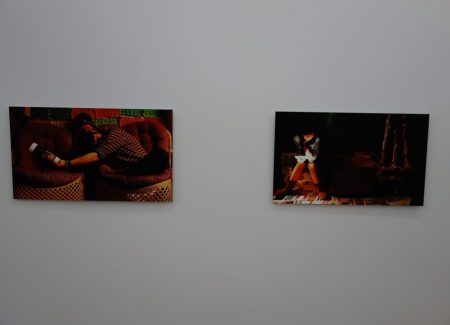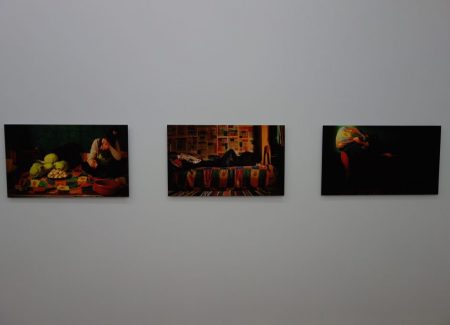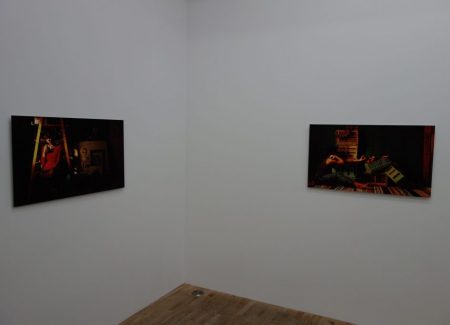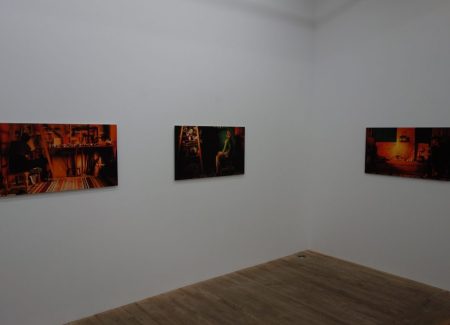JTF (just the facts): A total of 14 color photographs, unframed and unmatted, and hung against white walls in the front gallery space. All the works are c-prints, made in 2014. Each is sized 24×39 or 24×41 and is available in an edition of 4. (Installation shots below.)
Comments/Context: The Palestinian territory of Gaza is undeniably a difficult place to make art. Ruled by Hamas, dependent on and often at war with Israel, economically controlled by repeated occupations and blockades, and seemingly under a constant state of bombardment and tension, the challenges of everyday existence put the art that is created there through a kind of annealing process – it is born of strong emotions and real sacrifices, and often seems to simmer with latent distrust and outright anger.
But Nidaa Badwan’s artistic response to the situation in Gaza has been something altogether different. Instead of actively taking to the streets, she has retreated inside and turned inward, confining herself to the 100 square meters of her small room for some 20 months, making photographs of herself and the contents of her restricted space. Taking a siege mentality to its limits, she has created a new world within those cloistered and protected walls, using extreme isolation to catalyze her picture making.
It only takes a quick visual sweep of the images on view here to discover Badwan’s aesthetic signature – each photograph is bathed in warm embracing light, a seductive presence that moves from the pure white of the morning to the honeyed amber of the afternoon. Her use of light is unabashedly intimate and painterly and its presence activates her compositions, with dark chiaroscuro shadows that give way to Vermeer-like highlights and clarity. It’s as if this light was her only friend during the long days alone, and she went out of her way to welcome and celebrate it in all of its subtle (and often glorious) variations.
Compositionally, Badwan’s photographs are all elongated rectangles, which gives her some horizontal space to spread the action out. Action is perhaps a misstatement, as much of what takes place in these pictures does so very slowly, with a kind of patience and deliberateness that seems hushed. Domestic chores and roles fill many of the frames – sewing, cooking over a small burner, peeling onions (and crying), and bundling up the laundry. Other scenes are more overtly artistic, catching her at work at her easel or primly posed at her ancient manual typewriter; one image of her crouched down painting some wooden palettes feels like an echo of Cailebotte’s The Floor Scrapers, the alternating slats of dark and light creating a lovely rhythm.
While Badwan inhabits all of these pictures, she is more of a fleeting presence than a central subject. We rarely see her face, and when we do it is largely in profile or slightly turned away. As a result, her photographs feel more like lush still lifes than portraits, where objects and surfaces become the key players. Stacked wooden apple crates and loose straw, a muscular pile of light green cabbages, an A-frame ladder/bookshelf, some strands of twisted wire, a striped rug, some painted cardboard egg crates – each offers her a physical starting point rooted in color and texture, from which she builds single frame narratives and moments. Her images are both pared down and surprisingly full, especially when it comes to color – rolled up clothing, a patchwork quilt, and newspaper pages painted over with blocks of color bring energy and vitality to her gestures and moods, providing an engaging stage set for her self-imposed calm. Many of her compositions are deliberately unbalanced, pushing our eye to one side or the other, based on her presence or the organization of the space. It is as if we have entered an intimate dream, where thoughtfulness and boredom are transformed into ephemeral magic.
Like the resilience of the family of boys in the documentary film The Wolfpack who filled their constrained lives with reenacting famous movies, part of the charm found in Badwan’s photographs is their improvised economy and the richness she has drawn out of such humble raw materials. She’s leveraged the everyday contents of her apartment into a seemingly limitless theater of the mind, and that up close immediacy feels authentic and personal (rather than archly conceptual), even though the scenes are so obviously managed.
Even when Badwan captures herself in moments of weariness, loneliness, and listlessness, there is a muted almost stubborn joy in these pictures that is contagious. Badwan’s reaction to the war and conflict in Gaza has been to reject those anxious states of being and to manufacture a new more positive one out of the meager objects of her life. That can-do artistic spirit comes through strongly in these photographs, and it’s hard not to feel some optimistic uplift from such a personally risky commitment to the transformative power of art.
Collector’s POV: The prints in this show are priced in rising editions, starting at $4250 each and continuing up to $5500 each. Badwan’s work has no secondary market history, so gallery retail remains the best option for those collectors interested in following up.











Again and again, thank you for reviewing interesting work like this.